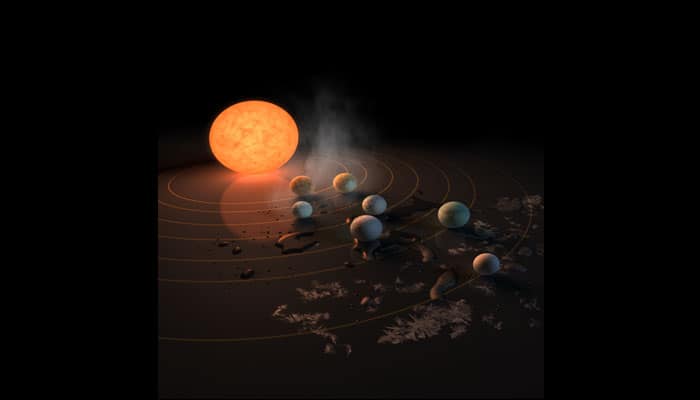New Delhi: Astronomers believe that NASA`s upcoming James Webb space telescope could help us find out if any of the seven earth-sized planets around the TRAPPIST-1 star 40 light years away could possibly support life.
Researchers are currently testing the James Webb Space Telescope which will be able to view these planets in the infrared, beyond the capabilities we currently have.
"If these planets have atmospheres, the James Webb Space Telescope will be the key to unlocking their secrets," said Doug Hudgins, Exoplanet Programme Scientist at NASA Headquarters in Washington.
"In the meantime, NASA's missions like Spitzer, Hubble, and Kepler are following up on these planets," said Hudgins.
Launching in 2018, one of Webb's main goals is to use spectroscopy, a method of analysing light by separating it into distinct wavelengths which allows one to identify its chemical components (by their unique wavelength signatures) to determine the atmospheric components of alien worlds.
The project is led by NASA along with European Space Agency and the Canadian Space Agency. It is the scientific successor to NASA's Hubble Space Telescope and will be the most powerful space telescope ever built.
The telescope will seek chemical biomarkers, like ozone and methane that can be created from biological processes.
Ozone, which protects us from harmful ultraviolet radiation on Earth, forms when oxygen produced by photosynthetic organisms synthesises in light.
Since the ozone is largely dependent on the existence of organisms to form, Webb will look for it in alien atmospheres as a possible indicator of life.
It will also be able to look for methane, which will help determine a biological source of the oxygen that leads to ozone accumulation.
The discovery of the planets in the TRAPPIST-1 system means that Webb will be able to use its immense capabilities on a relatively nearby system.
Researchers recently identified three promising planets in the TRAPPIST-1 system - e, f and g - which orbit in the habitable zone and would make good candidates Webb to study.
Depending upon their atmospheric composition, all three of these Earth-like exoplanets could have the appropriate conditions for supporting liquid water.
Since the planets orbit a star that is small, the signal from those planets will be relatively large, and just strong enough for Webb to detect atmospheric features.
"These are the best Earth-sized planets for the James Webb Space Telescope to characterise, perhaps for its whole lifetime," said Hannah Wakeford, postdoctoral fellow at NASA's Goddard Space Flight Centre in the US.
(With Agency inputs)
















